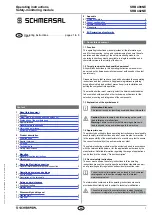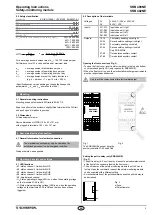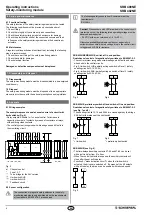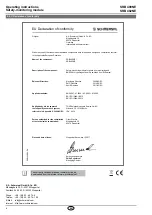
4
Operating instructions
Safety-monitoring module
SRB 400NE
SRB 402NE
EN
6. Set-up and maintenance
6.1 Functional testing
The safety function of the safety-monitoring module must be tested.
The following conditions must be previously checked and met:
1. Correct fixing
2. Check the integrity of the cable entry and connections
3. Check the safety-monitoring module's enclosure for damage
4. Check the electrical function of the connected sensors and their
influence on the safety-monitoring module and the downstream
actuators
6.2 Maintenance
A regular visual inspection and functional test, including the following
steps, is recommended:
1. Check the correct fixing of the safety-monitoring module
2. Check the cable for damages
3. Check electrical function
Damaged or defective components must be replaced.
7. Disassembly and disposal
7.1 Disassembly
The safety-monitoring module must be disassembled in a de-energised
condition only.
7.2 Disposal
The safety-monitoring module must be disposed of in an appropriate
manner in accordance with the national prescriptions and legislations.
8. Appendix
8.1 Wiring examples
The example represent a dual-channel control of a circuit with
limit switches (Fig. 4).
• Relay outputs: Suitable for 1 channel control, for increase in
capacity or number of contacts by means of contactors or relays
with positive-guided contacts.
• The control system recognises wire-breakage and earth faults in
the monitoring circuit.
A1 X5 X6 S31 S11 S12 S21 S22 X1 X2 S32 S41 S42 X3 X4
13 23 33 43
57 67
A2
F1
U
B
*
*
**
****
***
14
N
K
A
K
B
K
A
K
B
24 34 44
58 68
U
i
K1
K2
K5
K3
K4
K1
K2
K1
K2
K3
K4
K3
K5
K4
K
A
K
B
L1
K5
a)
a)
SRB 400NE / SRB 402NE
SRB 402NE
S
S
Fig. 4
a) Channel control
*
Fuse 1 A T
** To be bridge for the 24V version
*** Limit switch RHS
**** Limit switch LHS
S
Feedback circuit
8.2 Sensor configuration
The connection of magnetic safety switches to the safety-
monitoring modules is only admitted when the requirements
of the standard EN 60 947-5-3 are observed.
The following safety sensors from Schmersal meet the
requirements:
BN 20-2rz
Caution!
When sensors with LED are wired in the control circuit
(protective circuit), the following rated operating voltage must be
observed and respected:
– 24 VDC with a max. tolerance of –5 %/+ 20 %
Otherwise availability problems could occur, especially in
series-wired sensors, where a voltage drop in the control circuit
is triggered by LED's for instance.
SRB 400NE/SRB 402NE, switch-off in end position:
Dual-channel control of magnetic safety switches to EN 60947-5-3
• The control system recognises wire-breakage, earth faults and cross-
wire shorts in the control circuits.
• Fig. 5: limit switch LHS, partially acting on switch-off level 1 (safety
enabling circuits 13-14, 23-24)
• Fig. 6: limit switch RHS, partially acting on switch-off level 2 (safety
enabling circuits 33-34, 43-44)
S12
S11
S22
S21
S32
S31
S42
S41
Fig. 5
Fig. 6
SRB 402NE, preliminary switch-off and switch-off in end position:
Dual-channel control of magnetic safety switches to EN 60947-5-3
(see Fig. 7 and 8)
• The enabling circuits 13-14 and 23-24 are closed again by the bridge
X5-X6 after the release of the limit switch.
S12
S11
*
S22
S21
X6
X5
S32
S31
*
S42
S41
Fig. 7
* = limit switch
Fig. 8
* = preliminary limit switch
SRB 402NE (see Fig. 9)
• The time-delayed auxiliary contacts 57-58 and 67-68 can be set
with a pull-in delay from 0 to 5 sec.
• When the control contacts are opened, the auxiliary contacts will
close after the set pull-in delay.
• Function 5 ("brake activation circuit"): when the limit switch is
actuated, the drives are switched off. By means of the K5 outputs
with pull-in delay, the drives can be enabled with reduced speed.
58
57
K5
K5
68
67
Fig. 9
























